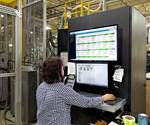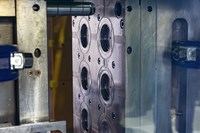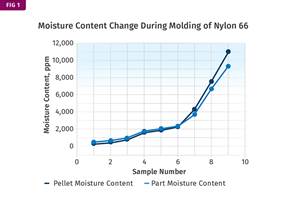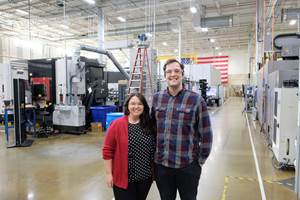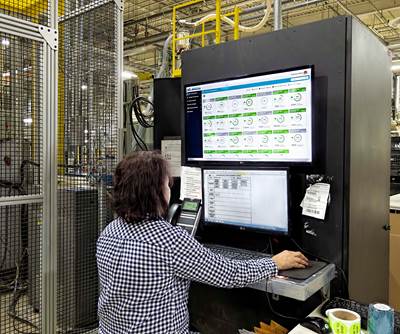Injection Molding Stock-Shape Parts in High-Temperature Materials
Patented technology is described as a hybrid that uses a specialized tool, a standard injection molding machine and off-the-shelf components to replace compression molding and extrusion for large stock shapes.
Lev Akopyan positions his patented displacement intrusion molding (DIM) process as a more effective alternative to standard compression molding and extrusion of large thick-walled stock shapes. Described as a hybrid variation of injection molding, extrusion and compression molding, the earliest iteration of the technology was originally developed by Akopyan and his father over 20 years ago, with the first related patent granted in 1999.
Those earlier processes utilized radio frequency and microwave heating of high-performance thermoplastics. While that enabled fast, volumetric heating of materials, Akopyan says it required custom equipment that entailed a sizeable initial capital investment and steep ongoing operating costs. “The tooling was quite exotic,” Akopyan explains, “and it was a little bit ahead of its time.”
Conversely, the newest version of DIM, which was awarded a U.S. patent in December 2024, applies readily available off-the-shelf equipment, making it more scalable and cost-effective, according to Akopyan, owner of Specialty Polymers, Olathe, Kansas.

The open DIM mold exposed the injection molded stock shape part. Source: Specialty Polymers
Depending on the stock part’s shape, the DIM system includes a square or cylindrical mold assembly, which is attached to a hydraulic cylinder and hydraulic pump. The mold features its own temperature control, and within the cylinder there is a movable plunger. The hydraulic pump drives the plunger, which consolidates the material within the mold. This mold assembly sits within a standard injection molding machine, utilizing the platens, along with other locking mechanisms when needed, to hold the mold halves together. The tonnage and daylight required for the press is determined by the part size. Akopyan says for the 8-inch tool, he is using a 400-ton Toyo machine with about 57 inches of daylight, but that press could support a larger mold.
The injection molding machine’s screw prepares and delivers the melt in “intrusion” mode, Akopyan says, where it’s simply rotating auger-melted material into the mold. Standard pellets are used versus the powder applied in compression molding. The reciprocating screw could be pushed forward at the end for a final packing of the part before the internal hydraulic plunger in the mold assembly gets to work or, Akopyan explains, “You can just apply intrusion all the way, and once the mold is filled, DIM does the final packing.”
Outside of the injection unit’s check-ring assembly, DIM has a valve which is closed on the mold to make sure material doesn’t leak out. The cooling process is where the process starts to look more like traditional compression molding. Depending on the material and part geometry, including wall and cross section thickness, cooling could take up to 8 hours. “You cannot rush it there,” Akopyan says.
High-Temp Materials, High-Performance Applications
DIM has been applied with various high-temperature high-performance resins, including PEEK, PEKK, DuPont’s Vespel (composite made from carbon fiber and Teflon fluorocarbon) and Torlon polyamide-imide (PAI). Some of the most impressive results leading to the most promising applications involve PBI Performance Products Inc.’s Celazole PBI (polybenzimidazole). Featuring a glass transition temperature (Tg) of 427°C, PBI imparts properties to its components that enable operation in extreme high-temperature, high-friction environments.
Included in the 2024 patent is the use of an inert gas, like nitrogen, to reduce the overall oxygen content or water vapor content of the plasticized feed material. “All these materials are hygroscopic,” Akopyan says, “so not only does it help us maintain the moisture content or levels to a minimum but we’re also reducing the oxidation and degradation of material.” He says this is especially true when the technology is working with long conditioning and fill times for large-dimension shapes.
The patent also explores the potential to place carbon fiber inserts into the mold cavity prior to intrusion injection, where these meshes could then become impregnated with the resin for a composite structure.
Postmolding, Akopyan acknowledges that most of the materials the DIM process works with have a high degree of shrink, making demolding easy. For something like Torlon, which does not, mold-release products are used. While there might be shrink, molded-in stresses are not an issue. “Because we plasticize the material and fill the mold fairly slow, we really don’t generate a lot of internal stresses,” Akopyan says. “We condition the part well, and we cool slowly for that reason.” That also means the process doesn’t require postmold treatments like annealing to “de-stress” parts.
Taking PBI Stock Shapes for a Spin
A commercial success for the DIM process includes the application of PBI’s Celazole T-Series compound, which combines PBI with PEEK, by a fabricator of spun aluminum lighting fixtures for its forming wheels. After switching to wheels made from Celazole in the DIM process, the fabricator noticed a brighter finish on its output thanks to the hardness of the Celazole, which meant the stock shape was closing the aluminum’s pores more tightly. The fabricator also reduced postmachine processing and has seen a 400% increase in service life over the PAI spinning wheels used previously.
Additional potential shapes include cylinders, rods, tubes and plates, with customers hailing from the aerospace, automotive, medical, and oil and gas exploration sectors, among others. Because Celazole PBI is already qualified for use in aerospace, that’s an area of immediate focus. For tubes, near net shape components with various inner diameters can be achieved without machining. There is a minimum cross section of 4 inches, with the ability to mold 6-inch-tall billets with an 8-inch outer diameter. Going forward, Akopyan sees the potential for 12-by-12-inch square plates with thicknesses from 2 to 6 inches. For round parts, 12-inch-tall billets or cylinders with a diameter of 12 inches could be intrusion molded.
Going forward, Akopyan thinks broader scale commercialization of the technology would be spearheaded by a larger company. “Ideally, we would want to hand over DIM to a large processor,” Akopyan says, with one option being a licensing agreement. “We’ve done a lot of the R&D, and obviously we have successful parts out of this process, but we would like to hand this over to a large processor.”

The DIM process is run on a standard 400-ton Toyo injection molding machine. Source: Specialty Polymers
Related Content
ICIS Launches: Ask ICIS Generative AI Commodities Assistant
Said to be the first of its kind, this AI assistant will enhance access to ICIS’ intelligence and insights for the energy and chemical markets.
Read MoreAutomotive Awards Highlight Emerging Technologies
Annual SPE Automotive event gives nods to several ‘firsts’ as well as sustainability.
Read MoreWhat's the Allowable Moisture Content in Nylons? It Depends: Part 2
Operating within guidelines from material suppliers can produce levels of polymer degradation. Get around it with better control over either the temperature of the melt or the barrel residence time.
Read MoreScaling Up Sustainable Solutions for Fiber Reinforced Composite Materials
Oak Ridge National Laboratory's Sustainable Manufacturing Technologies Group helps industrial partners tackle the sustainability challenges presented by fiber-reinforced composite materials.
Read MoreRead Next
Proprietary Tech Creates Stable Machining Grades of Polyolefin Stock Shapes
Quadrant will roll out an entire family of such materials within the next two years.
Read MorePeople 4.0 – How to Get Buy-In from Your Staff for Industry 4.0 Systems
Implementing a production monitoring system as the foundation of a ‘smart factory’ is about integrating people with new technology as much as it is about integrating machines and computers. Here are tips from a company that has gone through the process.
Read More

